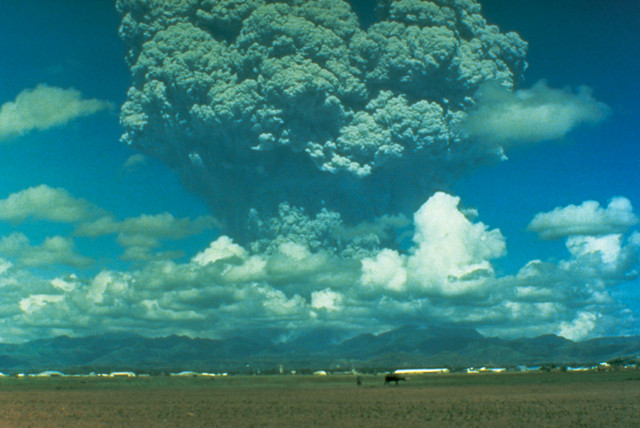
by Kate S. Zalzal Tuesday, February 7, 2017

On June 15, 1991, Mount Pinatubo sent a plume up 40 kilometers into the stratosphere. Credit: David H. Harlow, USGS.
Explosive volcanic eruptions can spew sulfur gas into the stratosphere — the layer of the atmosphere above where most clouds and weather occur — where it forms sulfate aerosols that reflect sunlight back into space and cool the planet. Now, researchers investigating how volcanic plumes could be affected by projected anthropogenic warming have found that, as temperatures rise, it becomes more difficult for volcanic plumes to reach the stratosphere.
“We know that volcanic eruptions can impact climate, but we wanted to know if this can happen in reverse too. … Can climate change impact how efficient volcanic plumes will be at cooling the planet in the future?” says Thomas Aubry, a doctoral student at the University of British Columbia in Vancouver and lead author of a new study in the Journal of Geophysical Research: Atmospheres.
Aubry and his colleagues used a volcanic eruption plume model, based on projected changes in atmospheric temperature and wind profiles as predicted by global climate models, to assess how high plumes are likely to ascend over the next 300 years. Climate model results were obtained by using three different greenhouse gas emissions scenarios characterized by low, medium and high greenhouse gas forcing and its associated impact on atmospheric temperatures over time. The eruption plume model itself was based on conditions — including plume temperatures and velocities, relative humidity, and atmospheric winds — during historical eruptions in 12 volcanically active regions.
“Plume height is a critical factor in how volcanic eruptions impact climate,” Aubry says. When plumes reach only into the troposphere, they tend to be quickly washed out by precipitation and thus have relatively little impact on climate. “But if an eruption plume reaches into the stratosphere, sulfate aerosols can circulate around Earth for over a year, scattering shortwave radiation, absorbing longwave radiation and causing a net cooling of the underlying troposphere,” he says. The most recent example of this was the global cooling that occurred for a couple of years following the 1991 eruption of Mount Pinatubo.
In the new study, the researchers found that under the medium and high greenhouse gas scenarios, fewer eruption plumes will reach into the stratosphere in the coming centuries. That’s because the troposphere is warming, Aubry says, and a warmer troposphere causes plumes to stop rising: Much like hot air balloons, volcanic plumes rise because they are warmer than the surrounding atmosphere. When the plume reaches an elevation where the air is of similar temperature and density, it stops rising and spreads out. A thicker and more stratified troposphere means that “volcanic eruptions will require more firepower” to reach elevations at which they can exert a cooling effect on the planet, Aubry says.
The work suggests a previously unrecognized positive feedback between climate and volcanic aerosol-radiation. As global warming reduces the frequency of stratospheric injections of volcanic plumes, the long-term average concentration of sulfate aerosol particles in the stratosphere will decline. This will reduce the albedo, or reflectivity, of the atmosphere, which, in turn, would enhance subsequent warming, Aubry says. Of further concern is that global carbon dioxide emissions currently exceed the values within the high greenhouse gas forcing scenario — meaning this process may be already underway.
“The results are surprising,” says Alan Robock, a climate scientist at Rutgers University who was not involved in the study. “I had never thought of this impact of global warming on the ability of eruptions to get sulfur into the stratosphere … it is an interesting new understanding of how the climate system works.”
Changes in volcanic plume behavior related to greenhouse gas concentrations will likely have only a small impact on the overall climate trajectory, Aubry says, but explosive eruptions matter a lot on shorter timescales. “Studies suggest that an increase in volcanic gases in the stratosphere was a driver of the recent climate hiatus,” he says, referring to an approximately 15-year period from 1998 to 2013 during which global warming appeared to slow.
Volcanic eruptions are unpredictable; consequently, few climate models incorporate changes in volcanic forcing into their projections, Robock says. But this study challenges assumptions about steady-state volcanic forcing. “Greenhouse gas-driven climate change could result in less cooling from volcanic eruptions,” Aubry says. “Our study gives a way to predict a trend in volcanic forcing.”
© 2008-2021. All rights reserved. Any copying, redistribution or retransmission of any of the contents of this service without the expressed written permission of the American Geosciences Institute is expressly prohibited. Click here for all copyright requests.